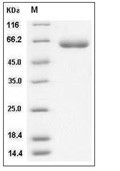 Your shopping cart is currently empty
Your shopping cart is currently empty
LBP Protein, Human, Recombinant (His)
Lipopolysaccharide binding protein ( LBP ) is a glycoprotein that is synthesized principally by hepatocytes. LBP is a trace plasma protein that binds to the lipid A moiety of bacterial lipopolysaccharides ( LPSs ). LBP binds directly to the outer membrane of Gram-negative bacteria and purified aggregates of extracted endotoxin and catalyzes the delivery of endotoxin to the membrane ( mCD14, GPI-Linked ) and soluble ( sCD14 ) forms of CD14, thereby markedly increasing host cell sensitivity to endotoxin. LBP efficiently catalyzes the transfer of individual molecules of endotoxin to (s)CD14 only when LBP–endotoxin aggregates are formed in the presence of albumin. In the presence of EDTA, LBP binding promotes further disaggregation of endotoxin. LBP binding does not have such drastic effects under more physiological conditions, but may still induce more subtle topological rearrangements of endotoxin.

LBP Protein, Human, Recombinant (His)
| Pack Size | Price | USA Warehouse | Global Warehouse | Quantity |
|---|---|---|---|---|
| 5 μg | $98 | 7-10 days | 7-10 days | |
| 10 μg | $159 | 7-10 days | 7-10 days | |
| 20 μg | $267 | 7-10 days | 7-10 days | |
| 50 μg | $528 | - | In Stock | |
| 100 μg | $902 | 7-10 days | 7-10 days | |
| 200 μg | $1,530 | 7-10 days | 7-10 days |
Product Information
| Biological Activity | Activity testing is in progress. It is theoretically active, but we cannot guarantee it. |
| Description | Lipopolysaccharide binding protein ( LBP ) is a glycoprotein that is synthesized principally by hepatocytes. LBP is a trace plasma protein that binds to the lipid A moiety of bacterial lipopolysaccharides ( LPSs ). LBP binds directly to the outer membrane of Gram-negative bacteria and purified aggregates of extracted endotoxin and catalyzes the delivery of endotoxin to the membrane ( mCD14, GPI-Linked ) and soluble ( sCD14 ) forms of CD14, thereby markedly increasing host cell sensitivity to endotoxin. LBP efficiently catalyzes the transfer of individual molecules of endotoxin to (s)CD14 only when LBP–endotoxin aggregates are formed in the presence of albumin. In the presence of EDTA, LBP binding promotes further disaggregation of endotoxin. LBP binding does not have such drastic effects under more physiological conditions, but may still induce more subtle topological rearrangements of endotoxin. |
| Species | Human |
| Expression System | HEK293 Cells |
| Tag | C-His |
| Accession Number | P18428 |
| Synonyms | lipopolysaccharide binding protein,BPIFD2 |
| Construction | Ala26-Val481 |
| Protein Purity | > 95% as determined by SDS-PAGE  |
| Molecular Weight | 52.5 kDa (predicted); 62 kDa (reducing condition, due to glycosylation) |
| Endotoxin | < 1.0 EU/μg of the protein as determined by the LAL method. |
| Formulation | 1. Lyophilized from a solution filtered through a 0.22 μm filter, containing 20 mM Tris, 100 mM NaCl, 0.05 mM EDTA, pH 8.0.Typically, a mixture containing 5% to 8% trehalose, mannitol, and 0.01% Tween 80 is incorporated as a protective agent before lyophilization.<br> 2. Lyophilized from a 0.2 μm filtered solution of 20mM Tris-HCl, 500mM NaCl, 1mM EDTA, pH 8.0. |
| Reconstitution | Reconstitute the lyophilized protein in distilled water. The product concentration should not be less than 100 μg/ml. Before opening, centrifuge the tube to collect powder at the bottom. After adding the reconstitution buffer, avoid vortexing or pipetting for mixing. |
| Stability & Storage | It is recommended to store recombinant proteins at -20°C to -80°C for future use. Lyophilized powders can be stably stored for over 12 months, while liquid products can be stored for 6-12 months at -80°C. For reconstituted protein solutions, the solution can be stored at -20°C to -80°C for at least 3 months. Please avoid multiple freeze-thaw cycles and store products in aliquots. |
| Shipping | In general, Lyophilized powders are shipping with blue ice. |
| Research Background | Lipopolysaccharide binding protein ( LBP ) is a glycoprotein that is synthesized principally by hepatocytes. LBP is a trace plasma protein that binds to the lipid A moiety of bacterial lipopolysaccharides ( LPSs ). LBP binds directly to the outer membrane of Gram-negative bacteria and purified aggregates of extracted endotoxin and catalyzes the delivery of endotoxin to the membrane ( mCD14, GPI-Linked ) and soluble ( sCD14 ) forms of CD14, thereby markedly increasing host cell sensitivity to endotoxin. LBP efficiently catalyzes the transfer of individual molecules of endotoxin to (s)CD14 only when LBP–endotoxin aggregates are formed in the presence of albumin. In the presence of EDTA, LBP binding promotes further disaggregation of endotoxin. LBP binding does not have such drastic effects under more physiological conditions, but may still induce more subtle topological rearrangements of endotoxin. |
Dose Conversion
Calculator
Tech Support
| Size | Quantity | Unit Price | Amount | Operation |
|---|

Copyright © 2015-2026 TargetMol Chemicals Inc. All Rights Reserved.



